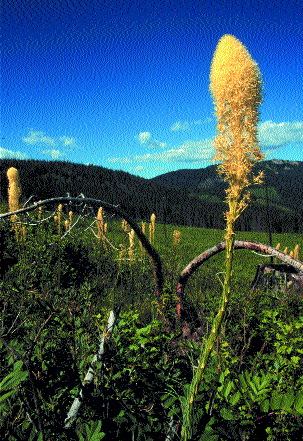Beargrass, lily of the high country
 Photo by Barb Pressler
Photo by Barb Pressler
By Dennis Nicholls
One of the most easily recognizable plants native to the Rocky Mountains is Xerophyllum tenax, commonly known as beargrass. The Selkirk and Cabinet mountain ranges of North Idaho are no exception. Though its vegetative parts resemble a clump of grass, this plant is actually in the lily family, and when in full bloom, it is as distinctive a plant as found anywhere.
Typically associated with high country, it's not unusual to see this grass-like native in frosty pockets with well-drained soils on the valley floor. But for the best show, wend your way into the mountains in June or early July. One can often find meadows where beargrass carpets the ground and stalks of flowers dance in the wind.
Its scientific name is derived from Latin words meaning "dry" (xeros), "leaves" (phyllon) and "tough" or "tenacious" (tenax). There is only one species that occurs in this region. The large white cluster at the top of the 3- to 5-foot high stalk is comprised of dozens of miniature flowers. There are so many of them, that each flower head looks like a giant light bulb, and some mountainsides will appear as though good ideas are going off all over the place.
The common name, beargrass, alludes to how bears utilize this plant. They dig the roots in spring for a tasty meal and will frequently gather the leaves for nesting material in dens, or as day beds during the summer. The flowers are a favorite snack of deer and elk, and at times a hiker can stumble upon an area of beargrass with hundreds of stiff, naked stalks minus the scrumptious flower heads.
Wildflower gardeners must be persistent and patient to grow beargrass. It's best to start from seeds, as transplanting is extremely difficult and is damaging to its native habitat. But once successfully established in a native-plant garden, beargrass, with its "light bulbs" of flower heads, will make it look like you just had good ideas going off all over the place!